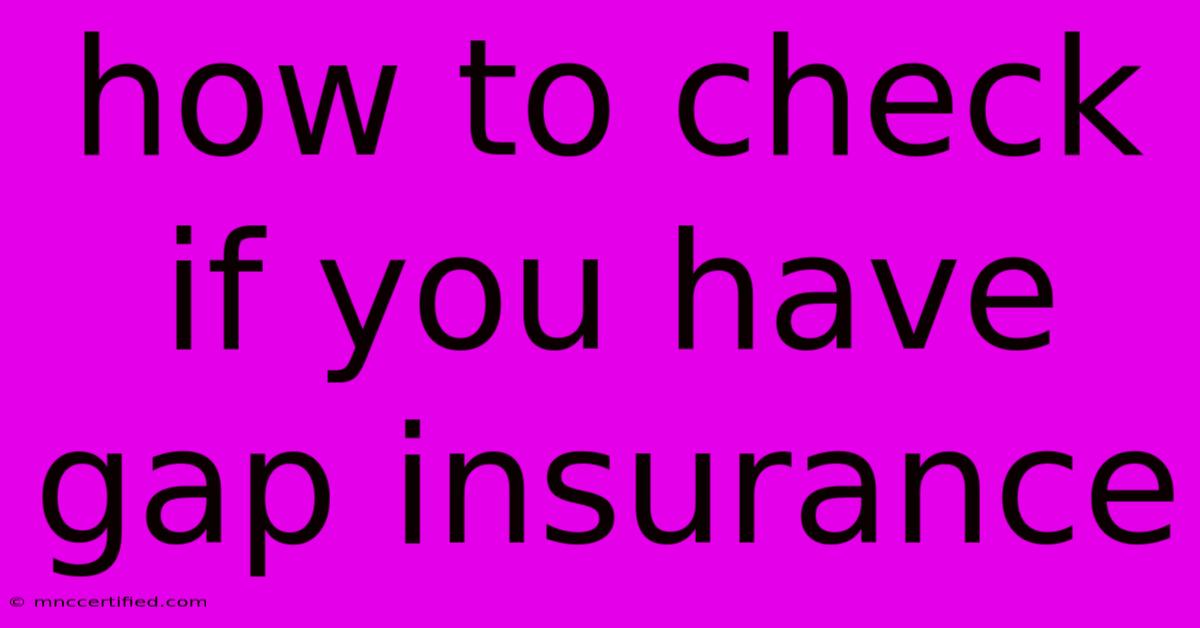How To Check If You Have Gap Insurance

Table of Contents
How to Check if You Have Gap Insurance: Protecting Yourself from Financial Loss
Gap insurance, also known as loan/lease gap insurance, is a crucial safeguard for car owners who want to avoid significant financial losses in case of a total vehicle loss. It bridges the gap between the actual value of your car and the outstanding loan or lease balance, ensuring you're not left footing a hefty bill after an accident. But how do you know if you already have this valuable coverage? Let's dive into the steps to check if you have gap insurance.
1. Review Your Auto Insurance Policy
The first step is to thoroughly examine your current auto insurance policy. Look for a section dedicated to "gap coverage" or "loan/lease gap insurance." If you find it listed as a part of your policy, you're good to go! The policy should also specify the coverage details, such as the deductible, coverage limits, and any specific terms and conditions.
2. Check with Your Lender or Leasing Company
If you can't find gap insurance mentioned in your auto insurance policy, contact your lender or leasing company directly. They are the ones who might have included gap insurance in your financing agreement. Ask them explicitly about the coverage, including its specifics and whether it's still active.
3. Contact Your Insurance Agent or Broker
Your insurance agent or broker is another valuable resource for verifying gap insurance coverage. They have access to your policy details and can help you decipher its specifics, especially if the language seems confusing. They can also clarify any questions you may have about the coverage.
4. Look for a Gap Insurance Certificate or Documentation
Finally, check your insurance paperwork for any certificates or documents related to gap insurance. This might be a separate document or included as part of your auto insurance policy documents.
If you don't find any evidence of gap insurance after following these steps, it's highly likely you don't have it.
Why Gap Insurance is Important
Gap insurance is especially crucial in the following situations:
- You financed your vehicle with a loan: When your car's value depreciates faster than the remaining loan amount, gap insurance covers the difference.
- You leased your vehicle: Leases usually have higher residual values than the actual market value of the car. Gap insurance helps pay the difference if your car is totaled before the lease term ends.
- You have a high loan-to-value ratio: If you borrowed a large amount of money against your car's value, gap insurance protects you from financial hardship in case of a total loss.
Getting Gap Insurance
If you find out you don't have gap insurance, don't worry! You can usually obtain it directly from your car insurance company or through your lender or leasing company.
Remember, securing gap insurance can save you from significant financial strain in case of an unfortunate event. Take the time to review your coverage and make sure you're adequately protected.
Keyword Optimization: gap insurance, loan gap insurance, lease gap insurance, auto insurance, car insurance, coverage, policy, lender, leasing company, insurance agent, broker, certificate, documentation, financial loss, total loss, car value, loan balance, residual value, loan-to-value ratio, financing agreement, protection.

Thank you for visiting our website wich cover about How To Check If You Have Gap Insurance. We hope the information provided has been useful to you. Feel free to contact us if you have any questions or need further assistance. See you next time and dont miss to bookmark.
Featured Posts
-
Scherzinger Draws Criticism For Russell Remark
Nov 09, 2024
-
Aldi Cheese Recall Affected Products And Safety
Nov 09, 2024
-
Investment Properties In Tampa Florida
Nov 09, 2024
-
2025 Grammy Nominees Beyonce Swift Lamar Top List
Nov 09, 2024
-
Nicole Scherzinger Apology For Brand Post Support
Nov 09, 2024